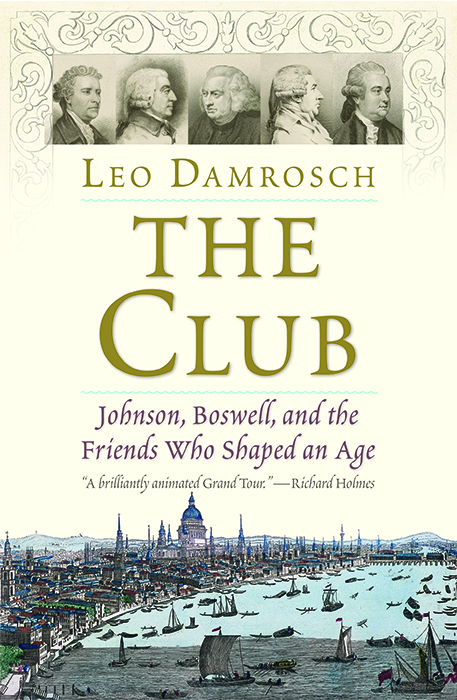
THE CLUB
Johnson, Boswell, and the Friends Who Shaped an Age
Prize-winning biographer Leo Damrosch tells the story of “the Club,” a group of extraordinary writers, artists, and thinkers who gathered weekly at a London tavern.
In 1763, the painter Joshua Reynolds proposed to his friend Samuel Johnson that they invite a few friends to join them every Friday at the Turk’s Head Tavern in London to dine, drink, and talk until midnight. Eventually the group came to include among its members Edmund Burke, Adam Smith, Edward Gibbon, and James Boswell. It was known simply as “the Club.”
In this captivating book, Leo Damrosch brings alive a brilliant,
Prize-winning biographer Leo Damrosch tells the story of “the Club,” a group of extraordinary writers, artists, and thinkers who gathered weekly at a London tavern.
In 1763, the painter Joshua Reynolds proposed to his friend Samuel Johnson that they invite a few friends to join them every Friday at the Turk’s Head Tavern in London to dine, drink, and talk until midnight. Eventually the group came to include among its members Edmund Burke, Adam Smith, Edward Gibbon, and James Boswell. It was known simply as “the Club.”
In this captivating book, Leo Damrosch brings alive a brilliant, competitive, and eccentric cast of characters. With the friendship of the “odd couple” Samuel Johnson and James Boswell at the heart of his narrative, Damrosch conjures up the precarious, exciting, and often brutal world of late eighteenth-century Britain. This is the story of an extraordinary group of people whose ideas helped to shape their age, and our own.
- Yale University Press
- Hardcover
- March 2019
- 488 Pages
- 9780300217902
About Leo Damrosch
Leo Damrosch is the Ernest Bernbaum Professor of Literature Emeritus at Harvard University. His previous works include the NBCC Award winner Jonathan Swift: His Life and His World, and Eternity’s Sunrise: The Imaginative World of William Blake.
Praise
“A magnificently entertaining book.”—Michael Dirda, Washington Post
“Damrosch’s magnificent history revives the Club’s creative ferment.”—New York Times Book Review, Editors’ Choice
“Impeccable scholarship at the service of absolute lucidity. . . . Learned, penetrating, a pleasure to read.”—Joseph Epstein, Wall Street Journal
“Engaging and illuminating . . . Damrosch is a crisp guide . . . He wears his learning lightly, and his sympathetic enjoyment is infectious. . . . we are transported back to a world of conversations, arguments, ideas, and writings. And in this vibrantly realized milieu, words rarely fail.”—Jenny Uglow, New York Review of Books
Discussion Questions
1. Members of the Club differed in many of their opinions (toward politics, travel, foreigners, the poor, women, etc.), and yet they enjoyed lively discussions and for the most part remained friends. What can we learn from them about maintaining civility?
2. What aspects of eighteenth century life appeal to you? Which customs, attitudes, or laws would seem intolerable?
3. Regardless of talent or education, women were specifically excluded from membership in the Club. Even so, Johnson valued women and had close relationships with several. Can you identify any advantages that women of the times enjoyed? How did they exert influence?
4. What sense do you get of different styles of marriage: loving (Garrick, Boswell), unhappy (Johnson), and polite but unromantic (the Thrales)? How did Boswell rationalize his compulsive recourse to prostitutes?
5. Reynolds promoted the idea of the Club with the intent of relieving Johnson’s bouts with depression through lively discussion, food, and drink that fueled weekly Friday night gatherings. Does your reading club or other group resemble the Turk’s Head Tavern gatherings in any way?
6. Despite the difficulties of travel in his day, Johnson adored speed and adventure. What aspects of his trip with Boswell to the Hebrides would appeal to you? Does the illustration depicting Johnson a treacherous seaside path that he clambered down (p. 258) change your opinion of his vitality?
7. Both Johnson and Boswell suffered difficult childhoods and illnesses while receiving minimal sympathy from their parents. Compare their experiences with those of children today.
8. Do you find the evidence convincing to suggest that Johnson would be diagnosed today with obsessive compulsive disorder, and Boswell with bipolar disorder and alcoholism?
9. If Boswell were contemplating a biography of a public figure or celebrity in the twenty-first century, who would you propose as an interesting subject?
10. Surprisingly, Boswell included Johnson’s eloquent argument against slavery in The Life of Samuel Johnson, then proceeded to defend the institution using terms like “humane” and “mercy.” Does this change your opinion of Boswell? What opinions or positions of our times would you regard as rationalizations?
